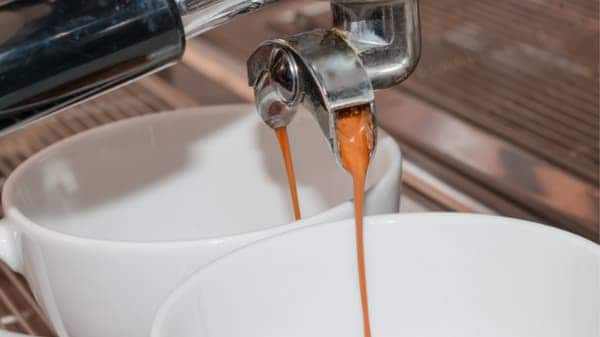Espresso Machine Heat Exchanger VS Dual Boiler
The choices in home espresso machines can seem endless these days.
When you want a prosumer espresso machine that gives you the power to make any kind of espresso drink, it does come down to two basic options: a heat exchanger or a dual boiler.
The differences can seem subtle, but they’ll have a big impact on how you pull your shots – and how high the price tag goes.
In this article, I will break down the differences and similarities between a heat exchanger VS dual boiler and help you decide which is best for you.

What Is a Heat Exchanger Espresso Machine?
The differences and similarities between a heat exchanger and a double boiler come down to how they heat the water to brew coffee.
An espresso machine boiler has two jobs:
- Create hot water to steam milk
- Create hot water to brew espresso
A heat exchanger espresso machine (also called an HX) has just one boiler. It utilizes the hot water from the steam boiler to apply the heat (or exchange it) to the group to brew espresso.
On the other hand, as you might realize from the name, a dual boiler espresso machine has two separate boilers, one to take care of each job.
Both a heat exchange and a dual boiler machine have the same process to heat water for steam, using a boiler. The difference is how they heat water for brewing.
We’ll be talking about dual boilers later on in the article. For now, let’s stick to heat exchangers.
You need two different temperatures to steam milk and to brew espressos. The steam boiler reaches a higher temperature of 250 degrees Fahrenheit to steam the milk.
But espressos need a lower temp and pressure, just around 200 degrees Fahrenheit.
Heat exchangers have been used since espresso machines were created. They use a simple process:
- The boiler heats water to around 250 degrees Fahrenheit to steam the milk
- Tubes of cold water run through the boiler
- Heat from the boiler is exchanged to those tubes
- The cold water in the tubes is heated to the right brew temperature
- The water in the tubes is directed to the group to brew espressos

So the metal boiler heats up and the tubes running from the boiler to the group exchange the heat from the boiler to the water in the tubes.
In that process, the temperature cools to around 200 degrees. It flows to the group head so you can pull the shot at the necessary lower temperature.
The purpose of the exchanger is to brew espressos at the right temperature, which is much lower than the temp for creating steam.
As you can imagine, there are no exact temp controls in this process, and water temp can vary several degrees while you’re pulling a shot. Many HX contain a PID that monitor and control temperature variations.
What are the pros and cons of an HX?
Pros:
- Water is fresher since it’s not held in a boiler until you use it
- A single boiler uses less energy
- Good for low volume setups
- Generally less expensive due to fewer materials
Cons:
- Since a heat exchanger has one large boiler that supplies heat for all functions, there’s little precision when it comes to creating consistent temps throughout each shot or for multiple shots in a row
- Cooling flush is needed to regulate the temperature
A quick word about the pumps that they use. Espresso machines have either a vibration pump or rotary pump. Some users prefer vibration pumps even though they’re louder than rotary pumps.
What Is a Double Boiler Espresso Machine?
A double boiler, not surprisingly, has two boilers inside. Those two boilers have two separate functions.
The large one, the steam boiler, heats water for steam, similar to what we already discussed in the HX. But a double boiler machine has a separate brew boiler for heating water to pull shots.
With dual boiler machines, as you pull the espressos, you’re drawing on water that is already heated.
The dual boiler maintains a specific amount of water at a consistent temperature. Of course, if you’re pulling shot after shot for some time, a dual boiler might struggle to maintain a consistent temperature.

But most home baristas won’t be pulling that many espressos at one time. Therefore, it’s easier to get consistent results because the water is held at a consistent temperature in the brew boiler.
A dual boiler has better steaming capabilities. And with many double boiler machines, you can turn off the steam if you’re just making espresso. Most double boilers have PID temperature control.
What’s the downside of a dual boiler? The cost.
Since you have twice the number of boilers, you have double the amount of materials for the second boiler, which increases the costs.
To sum up, what are the pros and cons of a dual boiler?
Pros:
- Gives you more control over stem and brew temperatures
- More stable temperatures
- Faster, no need to wait
Cons:
- More expensive
HX VS Dual Boiler Espresso Maker
What are the differences between making coffee with heat exchange machines and dual boilers?
A dual boiler can be easier for new baristas to master because the water temp is more consistent.
Each boiler maintains water at the right temp for steaming and for brewing. You get a lot more precision in your shots with a dual boiler.
They also heat accurately and maintain that heat so you can seamlessly pull shot after shot. The right temp helps you create consistent drinks each time.
On the other hand, a heat exchanger has a less consistent temperature.
Since all the water is at a high temperature and the brew water relies on transferred heat, the temperature will vary more. It takes skill to work with those variables.
But HX machines often have a more powerful boiler, which gives more steam power.
And they’re less expensive, making them more attractive to baristas on a budget. They are also cheaper to run, since there’s just a single boiler heating up water.
Wrapping Up
When deciding between a heat exchanger and a double boiler, consider what your needs are.
- Do you need a compact machine that’s capable of producing shot after shot, a power horse that will get the work done at less cost? Try a heat exchanger.
- If you need the most precise temp control to get the best tasting espressos regardless of the roast level or coffee type, consider a double boiler.
If you need both, you can upgrade to an HX that provides PID temperature regulation.
But with some espresso machine models, at that point, you’re getting into a major investment, which not every home barista is able to do.

